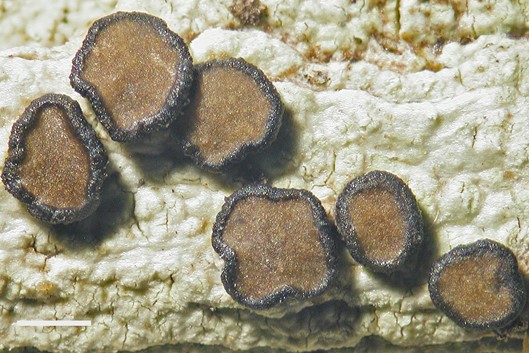Multisporidea nitida Kalb & Aptroot, gen. et sp. nov. Fig. 4
Index Fungorum number: IF 559332; Facesoffungi number: FoF
Malmideaceae with ascus with thickened tip with small central tubular amyloid structure (Malmideaceae-type), ascospores 16–32/ascus, almost globose, hyaline, 4–5 × 4–6 µm, apothecia glossy, chocolate brown, not pruinose, margin dark chocolate brown to black, conspicuously warty ornamented.
TYPE: RÉUNION. Cirque de Cilaos, road from Thermales to Roche Mervilleuse, on tree bark in rain forest remnant, 21°07ʹ S, 55°28ʹ30″ E, alt. c. 1450 m, 20 August 1991, K. Kalb & A. Kalb 25087 (B—holotype; ABL—isotype).
Thallus dull, whitish to pale pinkish brown, continuous, minutely indistinctly rimose, c. 0.05–0.1 mm thick, occasionally surrounded by an up to 0.3 mm wide black hypothallus. Algae chlorococcoid.
Apothecia sessile with strongly constricted base, turbinate to almost stalked, round to variably irregularly lobate, solitary or in dense groups with partly joining discs, c. 0.3–1.7 mm diam; disc flat and glossy, later somewhat convex, chocolate brown, not pruinose; margin dark chocolate brown to black, somewhat higher than the disc, glossy, rather wavy, conspicouously warty ornamented, c. 0.1–0.2 mm wide. Excipulum dark brown, contiguous with thin dark brown hypothecium. Epihymenium brown, up to c. 15 µm high. Hymenium a bit tinted brownish, c. 125 µm high. Ascus with thickened tip with small central tubular amyloid structure above the ascospores (Malmideaceae-type). Ascospores 16–32/ascus, almost globose, hyaline, 4–5 × 4–6 µm, wall c. 0.5 µm thick, without appendices or gelatinous sheath.
Pycnidia not observed.
Chemistry. No spot reactions. TLC: No secondary substances.
Etymology. The generic epithet refers to the polyspored asci and the specific epithet refers to the glossy apothecia.
Notes. This polysporous lichen does not fit any described genus well. At first sight it seems to be a Piccolia, but it misses all anthraquinones. Careful observation of the ascus revealed structures similar to the Malmideaceae, an until recently monotypic family of chiefly tropical corticolous lichens that now comprises five genera with in total around 60 known species (Cáceres et al. 2017, Kalb 2021). The genera in this family differ markedly between each other in ascospore shape (if known) and although polyspory is not yet reported, paucispory is fairly common in Malmidea. Polyspory occurs in more unrelated groups of lichenized fungi than commonly believed; Aptroot & Schumm (2012) mention at least 57 unrelated groups of polysporous lichenized fungi, to which the genus Amandinea should still be added.
Additional material examined: RÉUNION. Cirque de Cilaos, ascent from Thermales to Col du Taïbit, in a coppice, 21°07′ S, 55°28′ E, alt. 1300 m, 22. August 1999, K. Kalb & A. Kalb 33482 (Hb. K. Kalb).

Fig. 4: Multisporidia nitida (holotype), thallus and apothecia, bar 0.5 mm
Species
